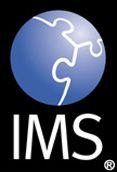 |
1EdTech Group Management Services WSDL Binding Version 1.0 Final Specification |
Copyright © 2004 1EdTech Consortium, Inc. All Rights Reserved.
The 1EdTech Logo is a registered trademark of 1EdTech Consortium, Inc.
Document Name: 1EdTech Group Management Services WSDL Binding
Revision: 11 June 2004
IPR and Distribution Notices
Recipients of this document are requested to submit, with their comments, notification of any relevant patent claims or other intellectual property rights of which they may be aware that might be infringed by any implementation of the specification set forth in this document, and to provide supporting documentation.
1EdTech takes no position regarding the validity or scope of any intellectual property or other rights that might be claimed to pertain to the implementation or use of the technology described in this document or the extent to which any license under such rights might or might not be available; neither does it represent that it has made any effort to identify any such rights. Information on 1EdTech's procedures with respect to rights in 1EdTech specifications can be found at the 1EdTech Intellectual Property Rights web page: http://www.imsglobal.org/ipr/imsipr_policyFinal.pdf.
Copyright © 2004 1EdTech Consortium. All Rights Reserved.
Permission is granted to all parties to use excerpts from this document as needed in producing requests for proposals.
Use of this specification to develop products or services is governed by the license with 1EdTech found on the 1EdTech website: http://www.imsglobal.org/license.html.
The limited permissions granted above are perpetual and will not be revoked by 1EdTech or its successors or assigns.
THIS SPECIFICATION IS BEING OFFERED WITHOUT ANY WARRANTY WHATSOEVER, AND IN PARTICULAR, ANY WARRANTY OF NONINFRINGEMENT IS EXPRESSLY DISCLAIMED. ANY USE OF THIS SPECIFICATION SHALL BE MADE ENTIRELY AT THE IMPLEMENTER'S OWN RISK, AND NEITHER THE CONSORTIUM, NOR ANY OF ITS MEMBERS OR SUBMITTERS, SHALL HAVE ANY LIABILITY WHATSOEVER TO ANY IMPLEMENTER OR THIRD PARTY FOR ANY DAMAGES OF ANY NATURE WHATSOEVER, DIRECTLY OR INDIRECTLY, ARISING FROM THE USE OF THIS SPECIFICATION.
Table of Contents
1. Introduction
1.1 Group Management Services Overview
1.2 Scope and Context
1.3 Structure of this Document
1.4 Nomenclature
1.5 References
2. Application of the WSDL Binding Guidelines
2.1 Synchronous Binding
2.2 Asynchronous Binding
3. Data Model XML Schemas Binding
3.1 <group> Element
3.2 <groupType> Element
3.3 <recordInfo> Element
3.4 <email> Element
3.5 <url> Element
3.6 <timeFrame> Element
3.7 <relationship> Element
3.8 <enrollControl> Element
3.9 <org> Element
3.10 <description> Element
3.11 <extension> Element
3.12 <groupSet> Element
3.13 <groupIdPair> Element
3.14 <groupIdPairSet> Element
3.15 <sourcedIdSet> Element
3.16 <pairSourcedIdSet> Element
4. Synchronous WSDL Binding
4.1 SOAP Specific Service Binding
4.2 Abstract Definition Binding
4.3 Message XML Schemas
4.3.1 'createGroupRequest' Message
4.3.2 'createGroupResponse' Message
4.3.3 'createByProxyGroupRequest' Message
4.3.4 'createByProxyGroupResponse' Message
4.3.5 'deleteGroupRequest' Message
4.3.6 'deleteGroupResponse' Message
4.3.7 'deleteGroupRelationshipRequest' Message
4.3.8 'deleteGroupRelationshipResponse' Message
4.3.9 'readGroupRequest' Message
4.3.10 'readGroupResponse' Message
4.3.11 'updateGroupRequest' Message
4.3.12 'updateGroupResponse' Message
4.3.13 'replaceGroupRequest' Message
4.3.14 'replaceGroupResponse' Message
4.3.15 'changeGroupIdentifierRequest' Message
4.3.16 'changeGroupIdentifierResponse' Message
4.3.17 'createGroupsRequest' Message
4.3.18 'createGroupsResponse' Message
4.3.19 'createByProxyGroupsRequest' Message
4.3.20 'createByProxyGroupsResponse' Message
4.3.21 'deleteGroupsRequest' Message
4.3.22 'deleteGroupsResponse' Message
4.3.23 'deleteGroupsRelationshipRequest' Message
4.3.24 'deleteGroupsRelationshipResponse' Message
4.3.25 'readGroupsRequest' Message
4.3.26 'readGroupsResponse' Message
4.3.27 'readGroupsForPersonRequest' Message
4.3.28 'readGroupsForPersonResponse' Message
4.3.29 'updateGroupsRequest' Message
4.3.30 'updateGroupsResponse' Message
4.3.31 'replaceGroupsRequest' Message
4.3.32 'replaceGroupsResponse' Message
4.3.33 'changeGroupsIdentifierRequest' Message
4.3.34 'changeGroupsIdentifierResponse' Message
4.4 Example SOAP Messages
5. Asynchronous WSDL Binding
Appendix A - WSDL Binding Listings
A1 - Synchronous Binding
A2 - Asynchronous Binding
About This Document
List of Contributors
Revision History
Index
1. Introduction
1.1 Group Management Services Overview
The Group Management Services specification [GroupService, 04] is the definition of how systems manage the exchange of information that describes people within the context of learning. The Group Management Services specification is constructed following the recommendations documented in the 1EdTech Abstract Framework (IAF) [AbsGloss, 03], [AbsASC, 03], [AbsWhite, 03]. This means that this specification is based upon the concepts of:
- Interoperability - Group Management Services focuses on the exchange of Group(s) information between Enterprise systems. There are no assumptions in the specification on how the data is managed within the Enterprise systems;
- Service-oriented - Group Management Services defines the exchange of information in terms of the services being supplied by the collaboration of the systems;
- Component-based - the Group Management Services will be combined with the Person Management Services and Membership Management Services to provide the Enterprise Service. Other services will be added to it in later releases;
- Layering - the Group Management Service is a part of the Application Services layer but it interacts with the services available in the Common Services layer e.g. authentication;
- Behaviors and Data Models - the Group Management Services are defined in terms of their behaviors and data models. The behaviors cause changes in the state of the data model and the state of the data model will only be altered as a result of a clearly defined behavior;
- Multiple Bindings - the Group Management Services information model is to be defined using the Unified Modelling Language (UML). This enables reliable mapping of the information model into a range of different bindings. The bindings of immediate importance are to the Web Services Description Language (WSDL);
- Adoption - the Group Management Services are based upon the original Enterprise specification data model. While there are significant changes the underlying data model has been maintained and the core Person structures remain.
1.2 Scope and Context
This document is the 1EdTech Group Management Services WSDL Binding v1.0 and as such it is used in conjunction with the following documents:
- 1EdTech Enterprise Services Core Use Cases v1.0 [EntServices, 04a] - the set of use-cases that are the basis for the definition of the Person Management Services Information Model;
- 1EdTech Group Management Services Information Model v1.0 [GroupService, 04] - the behavior and data model definition of the Group Management Services;
- 1EdTech Enterprise Services Best Practice & Implementation Guide v1.0 [EntServices, 04c] - this presents information that helps implementers adopt the specification;
- 1EdTech Enterprise Services Conformance Specification v1.0 [EntServices, 04b] - the definition of the conformance criteria that must be followed by systems that wish to claim compliance to the Enterprise Services Information Model.
As such the Person Management Services specification supersedes the original Enterprise specifications:
- 1EdTech Enterprise Information Model Final Specification v1.1 [Enterprise, 02a].
- 1EdTech Enterprise XML Binding Final Specification v1.1 [Enterprise, 02b];
- 1EdTech Enterprise Services Best Practice & Implementation Guide Final Specification v1.1 [Enterprise, 02c].
This WSDL binding takes the Group Management Service Information Model and produces an encoding of that description in WSDL. This WSDL binding is generated as recommended by the 1EdTech General Web Services documents [GWS, 04a], [GWS, 04b].
1.3 Structure of this Document
The structure of this document is:
1.4 Nomenclature
1.5 References
2. Application of the WSDL Binding Guidelines
2.1 Synchronous Binding
The WSDL bindings have been generated using the methodology documented in [GWS 04a] and [GWS, 04b]. The composition of the synchronous WSDL binding is shown in Figure 2.1.

The binding files described in Figure 2.1 contain:
- 'imsGroupManServiceSyncv1p0.wsdl' - the service specific WSDL binding file. For the Group Management Service this is based upon SOAP/http. This file imports the abstract definitions using the <wsdl:import> construct. The listing of this file is given in Appendix A;
- 'imsGroupManAbstractSyncv1p0.wsdl' - the abstract message definitions that represent the behavior of the Group Management Service operations. This file imports the message XSD using the <xsd:import> construct. The listing of this file is given in Appendix A;
- 'imsGroupManMessSchemav1p0.xsd' - the XSD definitions for the synchronous and asynchronous messages. This file imports the Group data model XSD using the <xsd:import> construct. The listing of this file is given in Appendix A;
- 'imsGroupManDataSchemav1p0.xsd' - the definition of the Group data model. This is the file that was produced by the equivalent data model binding in Enterprise v1.1. The listing of this file is given in Appendix A;
- 'imsMessBindSchemav1p0.xsd' - the XSD binding of the message header parts. This includes the message headers for synchronous, polled and asynchronous message models;
- 'imsCommonSchemav1p0.xsd' - the XSD binding of the 1EdTech Enterprise Service common data objects. This file is used by the Group message and data model XSDs as well as the 1EdTech message binding XSD;
- 'wsiwsdlv1p1.xsd' - this is the reference XSD for the WSDL definition. This file is the WS-I amended version of the original file from W3C;
- 'wsisoapv1p1.xsd' - this is the reference XSD for the SOAP extensions to WSDL. This file is from WS-I.
The name spaces used within these bindings are listed in Table 2.1.
2.2 Asynchronous Binding
Note: At the time of publication the Asynchronous Binding had not been tested. The details for creating the Asynchronous Binding are available in the 1EdTech Group Management Service WSDL Binding V2.0 Public Draft document. The Asynchronous Binding details will be issued in V2.0 of this document once testing has been completed.
3. Data Model XML Schemas Binding
3.1 <group> Element
The XSD visualization of the <group> data model is shown in Figure 3.1. This is the XML equivalent of the UML description in Figure 4.1 and Table 4.1 [GroupService, 04].
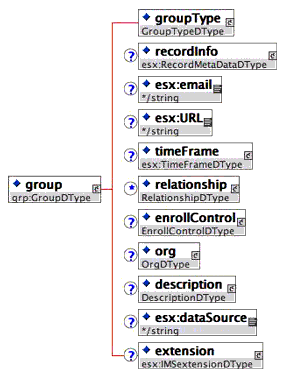
3.2 <groupType> Element
The XSD visualization of the <groupType> data model is shown in Figure 3.2. This is the XML equivalent of the UML description in Figure 4.1 and Tables 4.2, 4.3, 4.4, 4.5 [GroupService, 04].

3.3 <recordInfo> Element
The XSD visualization of the <recordInfo> data model is shown in Figure 3.3. This is the XML equivalent of the UML description in Figure 4.1 and Tables 4.1 [PersonService, 04].
3.4 <email> Element
See Table 4.1 and the OCL definitions in sub-section 4.1.4 [GroupService, 04].
3.5 <url> Element
See Table 4.1 and the OCL definitions in sub-section 4.1.4 [GroupService, 04].
3.6 <timeFrame> Element
The XSD visualization of the <timeFrame> data model is shown in Figure 3.4. This is the XML equivalent of the UML description in Figure 4.1 and Table 4.1 [GroupService, 04].
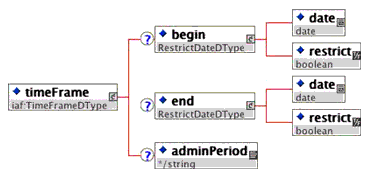
3.7 <relationship> Element
The XSD visualization of the <relationship> data model is shown in Figure 3.5. This is the XML equivalent of the UML description in Figure 4.1, Table 4.9 and the OCL definitions in sub-section 4.1.4 [GroupService, 04].

3.8 <enrollControl> Element
The XSD visualization of the <enrollControl> data model is shown in Figure 3.6. This is the XML equivalent of the UML description in Figure 4.1, Table 4.8 and the OCL definitions in sub-section 4.1.4 [GroupService, 04].

3.9 <org> Element
The XSD visualization of the <org> data model is shown in Figure 3.7. This is the XML equivalent of the UML description in Figure 4.1, Table 4.7 and the OCL definitions in sub-section 4.1.4 [GroupService, 04a].
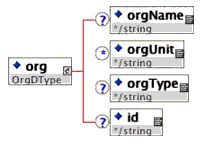
3.10 <description> Element
The XSD visualization of the <description> data model is shown in Figure 3.8. This is the XML equivalent of the UML description in Figure 4.1, Table 4.6 and the OCL definitions in sub-section 4.1.4 [GroupService, 04].
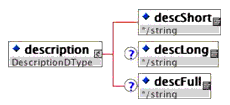
3.11 <extension> Element
The XSD visualization of the <extension> data model is shown in Figure 3.9. This is the XML equivalent of the UML description in Figure 4.1 and Table 4.1 [GroupService, 04].

3.12 <groupSet> Element
The XSD visualization of the <groupSet> data model is shown in Figure 3.10. This is the XML equivalent of the UML description in Figure 4.2 and Table 4.10 [GroupService, 04].
3.13 <groupIdPair> Element
The XSD visualization of the <groupIdPair> data model is shown in Figure 3.11. This is the XML equivalent of the UML description in Figure 4.3 and Table 4.12 [GroupService, 04].

3.14 <groupIdPairSet> Element
The XSD visualization of the <groupIdPairSet> data model is shown in Figure 3.12. This is the XML equivalent of the UML description in Figure 4.3 and Table 4.11 [GroupService, 04].
3.15 <sourcedIdSet> Element
The XSD visualization of the <sourcedIdSet> data model is shown in Figure 3.13.
3.16 <pairSourcedIdSet> Element
The XSD visualization of the <pairSourcedIdSet> data model is shown in Figure 3.14. This is the XML equivalent of the UML description in Figure 4.2 [CommonData, 04].

4. Synchronous WSDL Binding
4.1 SOAP Specific Service Binding
The key properties of the Specific Service binding files are detailed in Table 4.1. The Service Specific filename is: 'imsGroupManServiceSyncv1p0.wsdl'.
4.2 Abstract Definition Binding
The key properties of the Specific Service binding files are detailed in Table 4.2. The Abstract Definitions filename is: 'imsGroupManAbstractSyncv1p0.wsdl'.
| Property | Value |
|---|---|
| Port Type Name |
4.3 Message XML Schemas
4.3.1 'createGroupRequest' Message
This is the request message from the Reference Agent to the Sync Agent to invoke the 'createGroup()' operation. See 'createGroup()' sub-section of [GroupService, 04].

- sourcedId - the unique identifier to be assigned to the new Group record;
- group - the Group data to be stored in the new record.
4.3.2 'createGroupResponse' Message
This is the response message from the Sync Agent to the Reference Agent to complete the 'GroupPerson()' operation. See 'GroupPerson()' sub-section of [GroupService, 04].
The <createGroupResponse> element is empty.
Note: The status information is returned in the header of the SOAP transport message.
4.3.3 'createByProxyGroupRequest' Message
This is the request message from the Reference Agent to the Sync Agent to invoke the 'createByProxyGroup()' operation. See 'createByProxyGroup ()' sub-section of [GroupService, 04].
4.3.4 'createByProxyGroupResponse' Message
This is the response message from the Sync Agent to the Reference Agent to complete the 'createByProxyGroup()' operation. See 'createByProxyGroup()' sub-section of [GroupService, 04].
Note: The status information is returned in the header of the SOAP transport message.
4.3.5 'deleteGroupRequest' Message
This is the request message from the Reference Agent to the Sync Agent to invoke the 'deleteGroup()' operation. See 'deleteGroup()' sub-section of [GroupService, 04].
4.3.6 'deleteGroupResponse' Message
This is the response message from the Sync Agent to the Reference Agent to complete the 'GroupPerson()' operation. See 'deleteGroup()' sub-section of [GroupService, 04].
The <deleteGroupResponse> element is empty.
Note: The status information is returned in the header of the SOAP transport message.
4.3.7 'deleteGroupRelationshipRequest' Message
This is the request message from the Reference Agent to the Sync Agent to invoke the 'deleteGroupRelationship()' operation. See 'deleteGroupRelationship()' sub-section of [GroupService, 04].

- sourcedId - the identifier of the Group whose relationship is to be deleted;
- relationId - the identifier of the relationship to be deleted.
4.3.8 'deleteGroupRelationshipResponse' Message
This is the response message from the Sync Agent to the Reference Agent to complete the 'GroupPersonRelationship()' operation. See 'deleteGroupRelationship()' sub-section of [GroupService, 04].
The <deleteGroupRelationshipResponse> element is empty.
Note: The status information is returned in the header of the SOAP transport message.
4.3.9 'readGroupRequest' Message
This is the request message from the Reference Agent to the Sync Agent to invoke the 'readGroup()' operation. See 'readGroup()' sub-section of [GroupService, 04].
4.3.10 'readGroupResponse' Message
This is the response message from the Sync Agent to the Reference Agent to complete the 'readGroup()' operation. See 'readGroup()' sub-section of [GroupService, 04].
Note: The status information is returned in the header of the SOAP transport message.
4.3.11 'updateGroupRequest' Message
This is the request message from the Reference Agent to the Sync Agent to invoke the 'updateGroup()' operation. See 'updateGroup()' sub-section of [GroupService, 04].

- sourcedId - the identifier of the Group record to be changed;
- group - the Group data to be stored in the new record.
4.3.12 'updateGroupResponse' Message
This is the response message from the Sync Agent to the Reference Agent to complete the 'updateGroup()' operation. See 'updateGroup()' sub-section of [GroupService, 04].
The <updateGroupResponse> element is empty.
Note: The status information is returned in the header of the SOAP transport message.
4.3.13 'replaceGroupRequest' Message
This is the request message from the Reference Agent to the Sync Agent to invoke the 'replaceGroup()' operation. See 'replaceGroup ()' sub-section of [GroupService, 04].

- sourcedId - the identifier of the Group record to be changed;
- group - the Group data to be stored in the new record.
4.3.14 'replaceGroupResponse' Message
This is the response message from the Sync Agent to the Reference Agent to complete the 'replaceGroup()' operation. See 'replaceGroup()' sub-section of [GroupService, 04].
The <replaceGroupResponse> element is empty.
Note: The status information is returned in the header of the SOAP transport message.
4.3.15 'changeGroupIdentifierRequest' Message
This is the request message from the Reference Agent to the Sync Agent to invoke the 'changeGroupIdentifier()' operation. See 'changeGroupIdentifier()' sub-section of [GroupService, 04].

- sourcedId - the identifier of the Group whose identifier is to be changed;
- newSourcedId - the new identifier for the Group record.
4.3.16 'changeGroupIdentifierResponse' Message
This is the response message from the Sync Agent to the Reference Agent to complete the 'changeGroupIdentifier()' operation. See 'changeGroupIdentifier()' sub-section of [GroupService, 04].
The <changeGroupIdentifierResponse> element is empty.
Note: The status information is returned in the header of the SOAP transport message.
4.3.17 'createGroupsRequest' Message
This is the request message from the Reference Agent to the Sync Agent to invoke the 'createGroups()' operation. See 'createGroups()' sub-section of [GroupService, 04].
4.3.18 'createGroupsResponse' Message
This is the response message from the Sync Agent to the Reference Agent to complete the 'createPersons()' operation. See 'createPersons()' sub-section of [PersonService, 04].
The <createPersonsResponse> element is empty.
Note: The status information is returned in the header of the SOAP transport message.
4.3.19 'createByProxyGroupsRequest' Message
This is the request message from the Reference Agent to the Sync Agent to invoke the 'createByProxyGroups()' operation. See 'createByProxyGroups()' sub-section of [GroupService, 04].
4.3.20 'createByProxyGroupsResponse' Message
This is the response message from the Sync Agent to the Reference Agent to complete the 'createByProxyGroups()' operation. See 'createByProxyGroups()' sub-section of [GroupService, 04].
- sourcedIdSet - the set of unique identifiers that have been allocated by the Sync Agent to the newly created records.
Note: The status information is returned in the header of the SOAP transport message.
4.3.21 'deleteGroupsRequest' Message
This is the request message from the Reference Agent to the Sync Agent to invoke the 'deleteGroups()' operation. See 'deleteGroups()' sub-section of [GroupService, 04].
4.3.22 'deleteGroupsResponse' Message
This is the response message from the Sync Agent to the Reference Agent to complete the 'deleteGroups()' operation. See 'deleteGroups()' sub-section of [GroupService, 04].
The <deleteGroupsResponse> element is empty.
Note: The status information is returned in the header of the SOAP transport message.
4.3.23 'deleteGroupsRelationshipRequest' Message
This is the request message from the Reference Agent to the Sync Agent to invoke the 'deleteGroupsRelationship ()' operation. See 'deleteGroupsRelationship()' sub-section of [GroupService, 04].
- pairSourcedIdSet - the set of pairs of Group unique identifiers and relationship identifier for the relationships that are to be deleted.
4.3.24 'deleteGroupsRelationshipResponse' Message
This is the response message from the Sync Agent to the Reference Agent to complete the 'deleteGroupsRelationship ()' operation. See 'deleteGroupsRelationship ()' sub-section of [GroupService, 04].
The <deleteGroupsRelationshipResponse> element is empty.
Note: The status information is returned in the header of the SOAP transport message.
4.3.25 'readGroupsRequest' Message
This is the request message from the Reference Agent to the Sync Agent to invoke the 'readGroups()' operation. See 'readGroups()' sub-section of [GroupService, 04].
4.3.26 'readGroupsResponse' Message
This is the response message from the Sync Agent to the Reference Agent to complete the 'readGroups()' operation. See 'readGroups()' sub-section of [GroupService, 04].
Note: The status information is returned in the header of the SOAP transport message.
4.3.27 'readGroupsForPersonRequest' Message
This is the request message from the Reference Agent to the Sync Agent to invoke the 'readGroupsForPerson()' operation. See 'readGroupsForPerson()' sub-section of [GroupService, 04].
- personSourcedIdSet - the identifier of the Person whose Group membership records are to be returned.
4.3.28 'readGroupsForPersonResponse' Message
This is the response message from the Sync Agent to the Reference Agent to complete the 'readGroupsForPerson()' operation. See 'readGroupsForPerson()' sub-section of [GroupService, 04].
Note: The status information is returned in the header of the SOAP transport message.
4.3.29 'updateGroupsRequest' Message
This is the request message from the Reference Agent to the Sync Agent to invoke the 'updateGroups()' operation. See 'updateGroups()' sub-section of [GroupService, 04].
4.3.30 'updateGroupsResponse' Message
This is the response message from the Sync Agent to the Reference Agent to complete the 'updateGroups()' operation. See 'updateGroups()' sub-section of [GroupService, 04].
The <updateGroupsResponse> element is empty.
Note: The status information is returned in the header of the SOAP transport message.
4.3.31 'replaceGroupsRequest' Message
This is the request message from the Reference Agent to the Sync Agent to invoke the 'updateGroups()' operation. See 'updateGroups()' sub-section of [GroupService, 04].
4.3.32 'replaceGroupsResponse' Message
This is the response message from the Sync Agent to the Reference Agent to complete the 'replaceGroups()' operation. See 'replaceGroups()' sub-section of [GroupService, 04].
The <replaceGroupsResponse> element is empty.
Note: The status information is returned in the header of the SOAP transport message.
4.3.33 'changeGroupsIdentifierRequest' Message
This is the request message from the Reference Agent to the Sync Agent to invoke the 'changeGroupsIdentifier()' operation. See 'changeGroupsIdentifier()' sub-section of [GroupService, 04].
4.3.34 'changeGroupsIdentifierResponse' Message
This is the response message from the Sync Agent to the Reference Agent to complete the 'changeGroupsIdentifier()' operation. See 'changeGroupsIdentifier()' sub-section of [GroupService, 04].
The <changeGroupsIdentifierResponse> element is empty.
Note: The status information is returned in the header of the SOAP transport message.
4.4 Example SOAP Messages
The set of example SOAP/HTTP messages are described in Table 4.3. The 'Example File' entries are hot-text links to the files themselves.
5. Asynchronous WSDL Binding
Note: At the time of publication the Asynchronous Binding had not been tested. The details for creating the Asynchronous Binding are available in the 1EdTech Group Management Service WSDL Binding V2.0 Public Draft document. The Asynchronous Binding details will be issued in V2.0 of this document once testing has been completed.
Appendix A - WSDL Binding Listings
A1 - Synchronous Binding
The bindings listed below are for the synchronous SOAPv1.1/HTTPv1.1 based implementation. The set of binding files are given in Table A.1. These files can be accessed by 'clicking' on the appropriate file name.
| Property | Value |
|---|---|
| Service Specific File | /gms/wsdl/imsGroupManServiceSync_v1p0.wsdl |
| Abstract Definitions File | /gms/wsdl/imsGroupManAbstractSync_v1p0.wsdl |
| Messages XSD | /gms/xsd/imsGroupManMessSchema_v1p0.xsd |
| Data Model XSD | /gms/xsd/imsGroupManDataSchema_v1p0.xsd |
| Enterprise Common XSD | /services/common/imsCommonSchema_v1p0.xsd |
| Message Binding XSD | /services/common/imsMessBindSchema_v1p0.xsd |
A2 - Asynchronous Binding
Note: At the time of publication the Asynchronous Binding had not been tested. The details for creating the Asynchronous Binding are available in the 1EdTech Group Management Service WSDL Binding V2.0 Public Draft document. The Asynchronous Binding details will be issued in V2.0 of this document once testing has been completed.
About This Document
| Title | 1EdTech Group Management Services WSDL Binding |
| Editor | Colin Smythe (1EdTech) |
| Team Co-Lead | Chris Vento (WebCT Inc.) |
| Version | 1.0 |
| Version Date | 11 June 2004 |
| Status | Final Specification |
| Summary | This document presents the 1EdTech Group Management Services WSDL Binding. The original Enterprise specification was based upon the description of the data model for the information to be exchanged between communicating enterprise systems. The Enterprise Services specification extends this work by adding a series of behavioral models that define how the data models are to be manipulated. The material in this document describes the Web Services Description Language binding of the Group Management Services Information Model using SOAPv1.1/HTTPv1.1 as the underlying messaging and transport mechanism. This version supersedes the 1EdTech Enterprise v1.1 specifications. |
| Revision Information | 11 June 2004 |
| Purpose | This document has been approved by the 1EdTech Technical Board and is made available for adoption. |
| Document Location | http://www.imsglobal.org/es/esv1p0/imsgroup_bindv1p0.html |
| To register any comments or questions about this specification please visit: http://www.imsglobal.org/developers/ims/imsforum/categories.cfm?catid=20 |
List of Contributors
The following individuals contributed to the development of this document:
Revision History
Index
A
Abstract Framework 1, 2
API 1
Attributes
Common
extension 1
timeFrame 1 LangString
text 1 Membership
membership 1 Person
email 1
url 1 Relationship
relation 1 Result
result 1 Role
status 1, 2, 3, 4, 5, 6, 7, 8, 9 StatusInfo
description 1, 2, 3, 4, 5, 6, 7 UserId
authentication 1 Values
B
Binding technologies
SOAP 1, 2, 3, 4, 5, 6, 7, 8, 9, 10, 11, 12, 13, 14, 15
WSDL 1, 2, 3, 4, 5, 6, 7
C
Classes
Group 1, 2, 3, 4, 5, 6, 7, 8, 9, 10, 11, 12, 13, 14, 15, 16, 17
Description 1, 2, 3 Membership 1
Person 1, 2
Name 1 Common Services 1
Conformance 1, 2
E
Enterprise Service 1, 2, 3, 4, 5
G
Group Management Service 1, 2, 3, 4, 5, 6, 7, 8
M
Membership Management Service 1
Messages
Group
changeGroupIdentifierRequest 1, 2
changeGroupIdentifierResponse 1, 2
changeGroupsIdentifierRequest 1, 2
changeGroupsIdentifierResponse 1, 2
createByProxyGroupRequest 1, 2
createByProxyGroupResponse 1, 2
createByProxyGroupsRequest 1, 2
createByProxyGroupsResponse 1, 2
deleteGroupRelationshipRequest 1, 2
deleteGroupRelationshipResponse 1, 2
deleteGroupsRelationshipRequest 1, 2
deleteGroupsRelationshipResponse 1, 2, 3
readGroupsForPersonRequest 1, 2
readGroupsForPersonResponse 1, 2
updateGroupsResponse 1, 2 Person
createPersonsResponse 1
changeGroupIdentifier 1
changeGroupsIdentifier 1
createByProxyGroup 1
createByProxyGroups 1
createGroup 1
createGroups 1
deleteGroupRelationship 1
deleteGroups 1
deleteGroupsRelationship 1
readGroups 1
readGroupsForPerson 1
replaceGroups 1
updateGroup 1
updateGroups 1 Person
createPersons 1
P
Person Management Service 1, 2
S
Services
Group Management 1, 2, 3, 4, 5, 6, 7, 8
Membership Management 1
Person Management 1, 2
SOAP 1, 2, 3, 4, 5, 6, 7, 8, 9, 10, 11, 12, 13, 14, 15
1EdTech Consortium, Inc. ("1EdTech") is publishing the information contained in this 1EdTech Group Management Services WSDL Binding ("Specification") for purposes of scientific, experimental, and scholarly collaboration only.
1EdTech makes no warranty or representation regarding the accuracy or completeness of the Specification.
This material is provided on an "As Is" and "As Available" basis.
The Specification is at all times subject to change and revision without notice.
It is your sole responsibility to evaluate the usefulness, accuracy, and completeness of the Specification as it relates to you.
1EdTech would appreciate receiving your comments and suggestions.
Please contact 1EdTech through our website at http://www.imsglobal.org
Please refer to Document Name: 1EdTech Group Management Services WSDL Binding Revision: 11 June 2004

